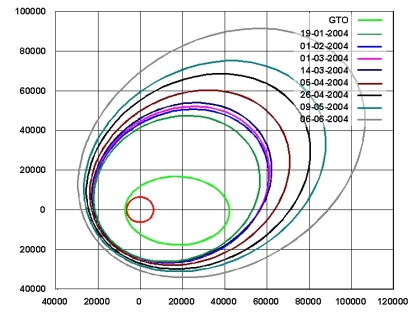No. 24 - Cruising beyond 100 000 km from Earth
The Electric Propulsion power has been throttled down again according the predictions of the solar array output power, from 1338 W to 1311 W. We are now approaching the minimum power (on early July) due to the Earth-Sun distance approaching maximum for the year.
The thruster change of state, caused by the varying amplitude of the anode current oscillation (see last report for more explanation) is now seen once every four pulses, where the last third of the pulse exhibits higher thrust and lower current oscillations. The thrust stays, for the most part, at around -1%, with +1.2% measured after the state change. No Optocoupler Single Event Transients, causing the flame-out, have been observed during this period.
Up to 6 June 2004, the electric propulsion system had cumulated a total ON time of about 2414 hours, consumed about 38 kg of Xenon (46% of the total propellant on board) and imparted to the spacecraft a velocity increment of about 1760 ms-1.
Systems Update
The Attitude and Orbit Control System (AOCS) has also performed nominally. A short double blinding, by the Earth and the Moon, of the Star Tracker camera heads occurred on 25 May and lasted for around 3 minutes.
The hydrazine consumption from the beginning of the mission until date, 6 June 2004, has been just 0.14 kg, leaving 7.95 kg. These numbers are the average obtained from the two independent hydrazine bookkeeping techniques used by the Flight Dynamics team.
The last Reaction Wheel offloading happened on 21 April, proving how well the Electric Propulsion gimbals control mechanism is keeping the spacecraft total momentum build-up at extremely low level.
We have recently detected a possible degradation of performance on one of the two transponders. A parameter measured on board seems to indicate a reduction of radiated power transmitted by the radio system presently in use. A test will be performed as soon as possible comparing the affected transmitter with the redundant one, measuring the power received at the ground station.
Science Update
Several cruise observations have been performed with the instruments:
- SPEDE/EPDP have continued the Electric Propulsion monitoring
- KaTE has been tested with the ESA Villafranca-4 station
- XSM has been monitoring, at apogee, the solar X-ray variations
- AMIE has made multicolour images of the Moon, and the laserlink experiment has been successfully demonstrated
- DCIXS has obtained first measurements of Sco-X1, and has started the cruise phase of synoptic observations programme of cosmic X-ray sources
The AMIE team had a meeting in Neufchatel, coinciding with taking the first SMART-1 images of the full Moon just before the lunar eclipse on 4 May.
The last STWT (Science and Technology Working Team) activities have dealt with the agreement on final lunar orbit with 3000 km apolune, the detailed cruise planning, and the preparation of the lunar science phase planning after the 17 November 2004 lunar capture.
Orbital/Trajectory information
The osculating orbital elements are periodically computed by the ESOC specialists. These elements define the so called "osculating orbit" which would be travelled by the spacecraft if at that instant all perturbations, including EP thrust, would cease. So it is an image of the situation at that epoch. In reality the path travelled by the spacecraft is a continuous spiral leading from one orbit to another. The most recent osculating elements are as follows:
|
EPOCH (UTC) 2004/06/06 10:26:29.3 Elements WRT Earth (J2000) |
|
| Pericentre Distance (km) |
25 711.947227 |
| Apocentre Distance (km) |
121 730.527113 |
| Semi Major Axis (km) |
73 721.237170 |
| Eccentricity |
0.651227 |
| Inclination (deg) |
6.786469 |
| Asc. Node (deg) |
140.985039 |
| Arg. of Pericentre (deg) |
216.649203 |
| True Anomaly (deg) |
179.954526 |
| Osc. Orbital Period (h) |
55.334681 |
In this diagram the osculating orbits at launch (GTO) and at different times are plotted. Clearly visible are the large effects that the operations of the electric propulsion have had on the orbit expansion. The height of the apogee, in particular, has dramatically increased and now exceeds 100 000 km.
 |
|
SMART-1 osculating orbit up to 6 June 2004 |
Since the start of the mission, the electric propulsion system has changed the orbital parameters as follows:
- The semi-major axis from 24 626 km to 73 721 km
- The perigee altitude from 656 km to 19 333 km
- The apogee altitude from 35 880 km to 115 352 km
- The orbital period from 10 hours 41 minutes to 2 days 7 hours 20 minutes
Contact Points
Giuseppe Racca
SMART-1 Project Manager
ESA/ESTEC - SCI-PD
Keplerlaan 1- 2200 AG Noordwijk, The Netherlands
E-mail: Giuseppe.Racca esa.int
esa.int
Bernard H. Foing
SMART-1 Project Scientist
ESA/ESTEC - SCI-SR
Keplerlaan 1- 2200 AG Noordwijk, The Netherlands
E-mail: Bernard.Foing esa.int
esa.int

